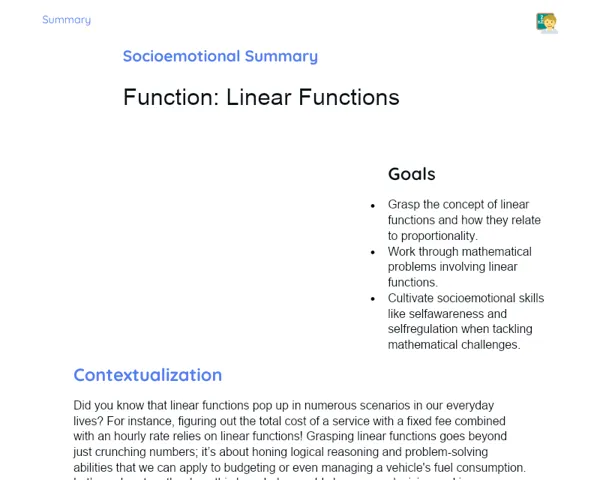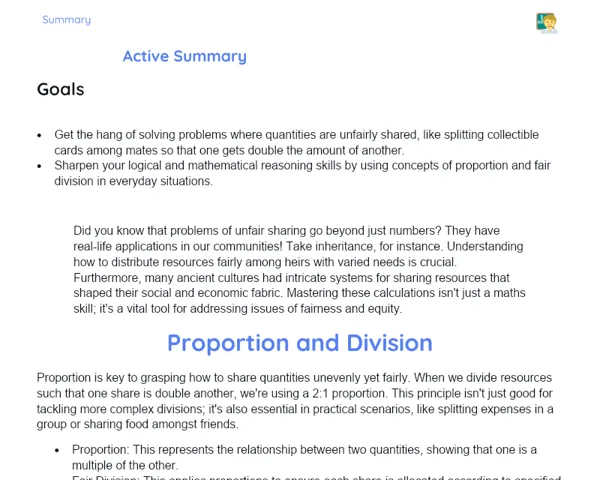Summary Tradisional | Addition and Subtraction of Decimal Numbers
Contextualization
Decimal numbers extend whole numbers and play a significant role in our everyday lives. They represent values that are not whole, such as prices, measurements for length, weight, volume, and data presented in charts and tables. Grasping the process of adding and subtracting decimal numbers is crucial for making accurate calculations during tasks like shopping, calculating change, measuring ingredients for recipes, and analysing data in reports and surveys.
In mathematics, there are specific rules for adding and subtracting decimal numbers that help simplify these operations. It's important to align the numbers by their decimal points to ensure accurate calculations. This alignment allows each decimal place to be added or subtracted correctly, minimising errors and ensuring clear results. In the lesson, we highlighted the significance of this alignment and how to apply it in various real-world scenarios.
To Remember!
Introduction to Decimal Numbers
Decimal numbers are a way to extend whole numbers, representing values that fall between whole numbers. They consist of an integer portion and a decimal portion, separated by a decimal point. The integer portion sits to the left of the decimal point, while the decimal portion is to the right. For instance, in the number 3.45, 3 is the integer part and 45 is the decimal part. Decimal numbers enable a more accurate representation of values, which is vital in daily activities like measuring quantities and calculating costs.
Understanding decimal numbers starts with correctly identifying the decimal point and differentiating between the integer and decimal segments. It's crucial to know that each digit after the decimal point represents a fraction of ten. For example, in the number 0.5, the 5 is in the tenths place, which signifies 5/10 or 0.5. Similarly, in 0.25, the 2 is in the tenths position, and the 5 is in the hundredths position, denoting 2/10 + 5/100, or 0.25.
Decimal numbers are commonly found in scenarios like shopping, where prices frequently appear in decimal form, and in measurements where precision is key. Therefore, being able to read and interpret decimal numbers is a fundamental skill that aids in accurate calculations and correct data interpretation.
-
Decimal numbers include both an integer part and a decimal part.
-
Each position after the decimal point corresponds to a fraction of ten.
-
Decimal numbers are frequently used in real-life situations to depict precise values.
Alignment of Decimal Numbers
For adding and subtracting decimal numbers, it’s vital to align the numbers by their decimal points. This alignment ensures that each decimal place relates correctly to its respective position, preventing mistakes in calculations. For instance, when adding 1.25 and 2.3, it's important to align them like this: 1.25 + 2.30, instead of 1.25 + 23.0. Proper alignment makes it easier to perform additions or subtractions from right to left.
When aligning decimal numbers, it’s crucial to pay attention to filling in zeros, if needed, to ensure each number has the same amount of decimal places. For example, to add 4.5 and 3.75, align them as 4.50 + 3.75. Filling in zeros doesn’t change the numbers’ value but simplifies the calculation, ensuring each column matches in decimal places.
Errors in the alignment of decimal numbers could result in inaccuracies. Hence, practicing correct alignment is essential for building proficiency with decimal operations. During the lesson, we stressed the importance of alignment and offered practical examples to demonstrate how to implement this technique.
-
Aligning decimal numbers by the decimal point is crucial for accurate calculations.
-
Fill in zeros when needed to standardise decimal places.
-
Practising proper alignment helps circumvent calculation errors.
Addition of Decimal Numbers
The process of adding decimal numbers resembles the addition of whole numbers, but with the need to align the numbers by their decimal points. After alignment, we add column by column from right to left. For example, when adding 3.45 and 1.76, the numbers align as follows:
3.45
+ 1.76
------
5.21
Initially, we add the decimal places from right to left. Adding 5 and 6 gives us 11, so we write down the 1 and carry over another 1. Next, we add 4 and 7, plus the carried-over 1, giving us 12. Finally, in the units place, we add 3 and 1, plus the carried-over 1, resulting in 5. Thus, the total is 5.21.
While performing addition, it's essential to verify that the numbers are properly aligned and that all decimal places have been accounted for. Any oversight can result in an incorrect answer. Moreover, consistent practice fosters accuracy and builds confidence in executing these operations. Throughout the lesson, we presented in-depth examples and hands-on exercises for students to engage with and reinforce their learning.
-
Align decimal numbers by the decimal point prior to addition.
-
Add column by column from right to left.
-
Practice decimal addition to develop accuracy and confidence.
Subtraction of Decimal Numbers
Subtracting decimal numbers also necessitates proper alignment of the numbers at their decimal points. This operation is carried out column by column from right to left. For instance, when subtracting 2.47 from 5.83, the numbers are aligned as follows:
5.83
- 2.47
------
3.36
First, we subtract the decimal places from right to left. Subtracting 7 from 3 means borrowing from the next column, changing the 3 to 13 and the 8 to 7, resulting in 6. Then, we subtract 4 from 7, which leaves us with 3. Finally, in the units position, we subtract 2 from 5, leaving us with 3. Therefore, the result of the subtraction is 3.36.
As with addition, it’s vital to check that the numbers are properly aligned and that all decimal places are included. Subtraction can be tricky, particularly when it involves borrowing values. Yet, consistent practice enables students to sharpen their skills and gain confidence in these operations. Throughout the lesson, we provided detailed examples and practical exercises for students to engage with and absorb what they’ve learned.
-
Align decimal numbers by the decimal point before commencing subtraction.
-
Subtract column by column beginning from the right.
-
Practice subtracting decimal numbers to improve skills and confidence.
Key Terms
-
Decimal Numbers: Numbers that consist of an integer part and a decimal part, separated by a decimal point.
-
Decimal Point: The symbol that separates the integer part from the decimal part in a decimal number.
-
Decimal Alignment: The method of aligning decimal numbers by their decimal points for proper addition and subtraction.
-
Decimal Places: The positions to the right of the decimal point that indicate fractions of ten.
Important Conclusions
In today’s lesson, we delved into adding and subtracting decimal numbers, recognising how they extend whole numbers and their importance for accurately representing specific values in daily life. We covered how to align numbers by their decimal points to ensure correct calculations and avoid errors. Students learned to add and subtract decimal numbers through in-depth examples and practical exercises, underlining the significance of regular practice to master precision and build confidence in mathematical operations.
Being able to effectively add and subtract decimal numbers is essential for everyday tasks like shopping, calculating change, measuring ingredients for recipes, and analysing data in charts and tables. Mastery of these operations enhances efficiency and reduces the chance for errors. Furthermore, the knowledge gained about decimal numbers and their related computations equips students to tackle more complex scenarios in personal and professional contexts in the future.
We encourage students to keep exploring this topic and to practise decimal number operations regularly. Familiarity with these mathematical concepts is key to developing advanced skills and applying them in various fields. Ongoing practice and seeking out new challenges will help solidify their understanding, making them more confident in executing accurate calculations.
Study Tips
-
Regularly practise adding and subtracting decimal numbers using real-life examples like product prices and recipe measurements. This aids in developing accuracy and confidence in operations.
-
Utilise extra resources such as textbooks, educational videos, and online exercises to enhance understanding of decimal numbers and their operations. Various sources can offer different perspectives and practical examples.
-
Form study groups with classmates to discuss and tackle problems involving decimal numbers. This exchange of knowledge and collaboration can help clarify doubts and foster deeper learning.



